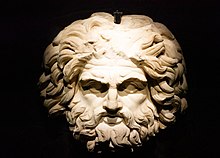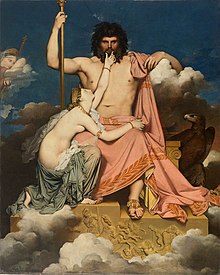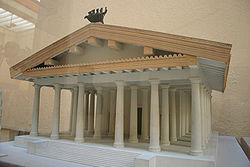Jupiter (mythology)
Jupiter (Latin: Iuppiter, also called Jove [Iovis]) is the chief god of Roman mythology, father of gods and men (pater deorum et hominum). The Greek equivalent of him is Zeus (in ancient Greek Ζεύς [ Zeús ]), although this Latin deity was not taken from Greek mythology, as it was in other cases. His attributes are the eagle, the lightning bolt and the scepter.
Today, the god Jupiter is worshiped by pagan reconstructionism religious groups such as the Roman Road to the Gods, Nova Roma, among others, who seek the renewal of ancient Roman religion.
Son of Saturn and Ops, Jupiter was the supreme deity of the Capitoline triad, also made up of his sister and wife, Juno, and his daughter, Minerva.
The cult of Jupiter, of probable Sabine origin, was introduced to Rome by Numa Pompilius. In the largest Roman temple, built in his honor on the Capitoline Hill, he was venerated as Iuppiter Optimus Maximus ('Jupiter, the best and greatest'), protector of the City, from whom authority, laws and social order emanate. Cicero calls it numen praestantissimae mentis, "the overwhelming presence of a supreme mind".
During the Republic, it was the divinity to which the consul addressed his prayers at the beginning of his mandate. In the Empire, with the introduction of the imperial cult, Jupiter ceased to be the only personification of the greatest greatness, although several emperors they made him their tutelary god, or they incorporated his attributes into themselves. Caesar Augustus claimed to have dreams sent directly by Jupiter.Caligula called himself Optimus Maximus , and communicated, by means of a bridge, his palace, on the Palatine Hill, with the Temple of Jupiter Capitolinus.
Etymology
The Latin word Iuppiter (Jupiter) comes from the Indo-European roots dyu-, meaning "light", and piter, which refers to pater, meaning "father"; that is: The father of light. As for the Latin word deus ("god"), as well as its variant divus ("divino", or "divinity"), which are both at the base of the Spanish word "dios", literally mean " being of light", since it was understood that the gods were made of the same material as light. This origin is also at the base of the word Iovis ("Jove", another name for Jupiter, from which the Spanish word "jovial" comes from). On the other hand, the Greek word Zeus also comes from an Indo-European root: dyeuis.
Myth
As with much of Roman mythology, the Jupiter myth closely follows that of Zeus from Greek mythology, with borrowings from Etruscan mythology and lank native elements.
Originally, Jupiter was considered a god of the sky, the weather and agricultural cycles. Later he was protector of the confederation of Latin cities, until over time he adopted attributes in accordance with the Roman State, justice, law and the authority of the laws, although he retained elements of his previous conception, such as being the bearer of lightning to the just like Zeus in Greek mythology; and, like him, eventually became the god of gods.
Birth and accession to the throne
Saturn, the youngest son of Coelus and Terra, devoured his own children, thus fulfilling the condition that his older brother, Titan, had imposed on him to rule, so that Titan's offspring could later reach the throne of sovereignty over the rest of the gods. However, Ops, wife of Saturn, managed to remove Jupiter, Neptune and Pluto from that fate. He hid Jupiter on the island of Crete, where the goat Amalthea nursed him. Instead of Jupiter, Ops gave her husband a stone wrapped in swaddling clothes, which Saturn devoured.
Once he was grown, Jupiter made war against Titan first, and then against his father, until he was dethroned. Saturn had devoured his daughters, Vesta, Ceres, and Juno. It was necessary, for him to return them, an emetic prepared by Metis. Jupiter immediately assigned Neptune the kingdom of the seas, and Pluto the Underworld, and then married his sister Juno.
Epithets
Jupiter had numerous epithets:
Epithets denoting functionality
- Iuppiter Optimus Maximus (‘the best and greatest’)
- Iuppiter Caelestis (“celestial”)
- Iuppiter Custos (’guardian’)
- Iuppiter Conservator (’defensor, conservative’)
- Iuppiter Fulgur (‘the one holding the lightning’)
- Iuppiter Fulgurator ('The Lightning')
- Iuppiter Tonans (‘tonante’)
- Iuppiter Liberator, (‘liberator’), free from life giving a good death
- Iuppiter Lucetius (‘Light’)
- Iuppiter Pluvius (‘He who sends rain’)
- Iuppiter Stator (de) stare“To stand”
- Iuppiter Victor (‘victory’, as a guide to the armies towards victory)
- Iuppiter Triumphator (‘triunfante’)
- Iuppiter Invictus (‘invencible’)
- Iuppiter Imperator (‘Supreme Commander’)
- Iuppiter Terminus or Iuppiter Terminalus (‘Defensor of borders’)
- Iuppiter Praedator (‘boot’)
- Iuppiter Summanus (‘he who sends night thunder’)
Geographic or syncretic epithets
- Iuppiter Ammon (Jupiter equipped with the Egyptian god Amon after the Roman conquest of Egypt)
- Iuppiter Brixianus (as the equivalent of the local god of Brescia in Gaul Cisalpine)
- Iuppiter Heliopolitanus (from the Heliópolis Siríacamodern Baalbek, Lebanon; a form of Baal)
- Iuppiter Ladicus (as the equivalent of the Celtish god of the mountains and worshiped as the spirit of Mount Ladicus)
- Iuppiter Latarius (‘del Lacio’)
- Iuppiter Parthinus or Partinus (as he was worshiped at the borders of Dalmatia and Mesia, perhaps associated with the local tribe known as the Midianites)
- Iuppiter Poeninus (as he was worshiped in the Alps, in the area of the Great Saint Bernard, where he had a sanctuary)
- Iuppiter Solutorius (a local version worshiped in the area of Castile, where it was syncretized with the local Iberian god Eacus)
- Iuppiter Taranis (equipped with the Celtic god Taranis)
- Iuppiter Uxellinus (as was worshiped in Austria, as a god of the high mountains)
- Iuppiter Sabazius (jupiter syncretization with Yahveh (Jehovah))
Capitolian Jupiter
The Temple of Jupiter Optimus Maximus, built on the Capitoline Hill, was the largest Roman temple. There he was worshiped in the form of a sacred stone, known as the Jupiter Lapis, on which oaths were sworn. In this temple he was worshiped together with his wife and queen Juno and his daughter Minerva (the goddess of wisdom), forming the Capitoline Triad.
It was common for the Romans to build temples dedicated to Jupiter Optimus Maximus or the Capitoline Triad in the center of new cities in the colonies.
The Temple of Jupiter on the Capitoline Hill was started by Tarquinio Priscus and completed by the last king of Rome, Tarquinio the Proud, although it was inaugurated, according to a tradition recorded by historians, on September 13, at the beginning of the Republican era (509 BC). It stood on a high podium with an entrance stairway in front. On three of its sides it was probably flanked by a colonnade and had two other rows of pillars arranged in line with those on the façade to form a deep pronao preceding the three cellae which ran from side to side in the Etruscan manner, the central one being wider than the other two.
The surviving remains of the foundations and the podium, most of which lies beneath the Palazzo Caffarelli, are made up of huge parallel sections of walls made of square blocks of tosca gray (cappellaccio) that record the total size of the surface area of the base of the temple (about 55×60).
On the roof was a terracotta charioteer, made by the Etruscan artist Vulca of Veii in the 6th century BC. C., commissioned by Tarquinio the Proud, which was replaced in 296 BC. C. for a bronze one. The cult image, also the work of Vulca, was made of terracotta and its face was painted red on festival days. Under the cellae were the favissae or underground passages., in which were stored old statues that had fallen from the roof and various dedicated offerings.
The temple was rebuilt in marble after it was completely destroyed by fire in 83 BCE. C., when the cult image was lost, as well as the Sibylline Books kept in a stone chest. It suffered other fires in 69 AD. C., when the Capitol was assaulted by supporters of Vitellius, and in 80 d. c.
In front of the steps was the altar of Jupiter (ara Iovis). In the great square in front of the temple (the Plaza Capitolina) there were several temples dedicated to minor divinities, in addition to other religious buildings, statues and trophies.
Its dilapidation began in the fifth century, when Stilicho removed the golden gates and Narses removed many of the statues in 571.
In the language
In Ancient Rome people swore by Jupiter in courts of law, leading to the common expression "by Jupiter!", used as an archaism today. Furthermore, "jovial" is a relatively common adjective used to describe someone who is cheerful, easy-going, and optimistic.
Contenido relacionado
Amimitl
Rape of the Sabine Women
Metis (mythology)




